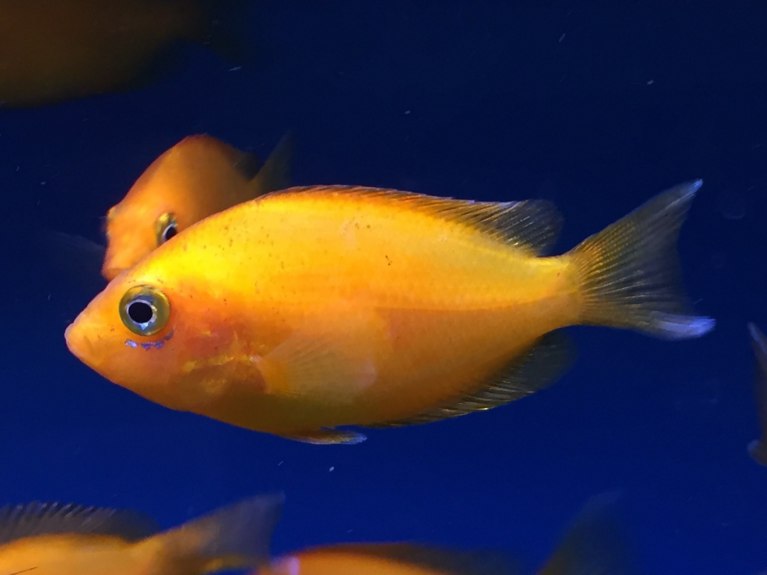Cookie Policy
We use cookies to help improve the experience you have on this site. You can find out more here.
We use cookies to help improve the experience you have on this site. You can find out more here.

| Synonyms | Etroplus maculatus, Chaetodon maculatus, Glyphisodon kakaitsel |
| Distribution | India and Sri Lanka. |
| Maximum Size | 9.5cm (3.7") |
| Temperature | 20-26°C |
| Water Parameters | Hard and alkaline. Fresh or brackish. pH: 7.2-8.5, dH: up to 25 degrees. |
| Compatibility | Specialist community |
| Lighting | No special requirements |
| Sexual Dimorphism | No obvious external differences. |
| Feeding | Spirulina flake, granules,cichlid pellets and frozen foods |
Care
The Orange Chromide is found in a variety of habitats including estuaries, the lower reaches of rivers, heavily vegetated streams, and weedy lagoons, and is one of only a handful of cichlid species known from Asia. In addition to the rarely seen wild form (named for the subtle orange tones) a bright orange aquarium form is more frequently seen, occasionally labelled as Red chromide. Females of both forms can be distinguished by the white margins to the caudal fin.
These fish can be kept in either hard and alkaline freshwater or brackish water aquaria, providing they are acclimatised carefully. However, soft, acidic water must be avoided. The aquarium should be mature and as spacious as possible. There should be a soft sandy substrate and a multitude of shady hiding places/visual barriers provided amongst robust planting, rocks, driftwood, flowerpots on their sides etc whilst still maintaining an unrestricted expanse along the front of the aquarium for these active swimmers. Filtration should be efficient with moderate current and a good level of oxygenation. Frequent partial water changes are absolutely essential, as Orange Chromides are particularly sensitive to the build up of nitrate in the aquarium. This species is relatively peaceful (unless breeding) and is best kept in groups due to its gregarious nature. Smaller numbers may result in dominant individual/s picking on the weaker fish; larger groups sizes will ensure that no one fish is continually picked on, with any bickering being spread amongst the shoal. This will also result in an attractive, more natural-looking display. Orange Chromides can be kept safely alongside many species, and choice of tankmates will depend on whether the fish are being maintained in fresh or brackish water. In freshwater aquaria, good tankmates could include danionins, rainbowfish, and rasboras, whereas those in brackish water could be kept alongside some of the larger sized livebearers such as mollies. Tiny fish may be eaten so are best avoided, likewise do not house with large, boisterous species as the chromides will become nervous. Interestingly, in the wild, juvenile Orange Chromides have been observed cleaning their larger sympatric relative, the Banded Chromide (Etroplus suratensis), in a fashion similar to that of some of the marine wrasses.
Feeding
Omnivorous. Flake, green flake, and slow-sinking pellets/granules can be given, but frozen foods such as Spirulina-enriched brineshrimp, bloodworm, white mosquito larvae, Mysis shrimp etc are preferred. It is important that these fish are provided with a good amount of vegetable matter such as blanched spinach, kale, Romaine lettuce, dried seaweeds etc.
Breeding
Orange Chromides are bi-parental substrate spawners, and have been bred in the home aquarium in both fresh and brackish water. The parent fish will select a flat rock in a sheltered location and clean it. Up to 200 eggs will be deposited on the cleaned rock, and these will be guarded by both parents. The eggs should hatch within 2-5 days (temperature dependent), and the parents will move the wrigglers amongst several pre-dug pits until they absorb their yolk sacs and become free-swimming after a further 2-3 days. At this point they may feed on the parents' body mucus. The parents will care for their young for an extended period of time, until they are large enough to defend themselves and are almost reaching sexual maturity.
© 2025 Maidenhead Aquatics Ltd. All Rights Reserved. No part of the content on this page may be reproduced for distribution or commercial gain in line with our Terms and Conditions.
For delivery before Christmas, orders must be placed on or before 3pm on Wednesday 20th December. We cannot guarantee delivery of these orders pre-Christmas as we are reliant on our couriers, but will use our best endeavours to get orders placed on this date out to you before Christmas. For full details of our festive delivery and opening times click here
Please note: online orders placed after 3pm on Friday 22nd December will not be dispatched until the New Year. For full details of our festive delivery and opening times click here